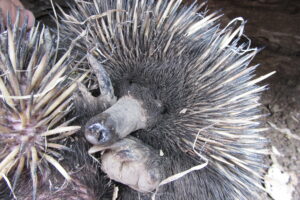
One of the privileges of living in an Outback Queensland town is that sometimes we are visited by some really cool creatures. This young Short-beaked Echidna Tachyglossus aculeatus was rescued yesterday when it ventured into a yard in suburban Roma. It was foraging for termites around some garden bed sleepers. Some caring locals alerted us to its presence and the potential danger it was in from neighbouring dogs and nearby traffic.
There’s only one type of echidna in Australia, called the short-beaked echidna. However, they can look a little bit different depending on where you are in Australia. For example, the ones in Tasmania are much more hairy to help deal with the cold. Three other types of echidnas occur in New Guinea and Indonesia – they too look different to ours with their much longer noses.
short-beaked echidna. However, they can look a little bit different depending on where you are in Australia. For example, the ones in Tasmania are much more hairy to help deal with the cold. Three other types of echidnas occur in New Guinea and Indonesia – they too look different to ours with their much longer noses.
Echidnas are not marsupials, which is a common misconception. They’re actually monotremes, like a platypus. This means that they lay an egg into a pouch, which then hatches and develops in the pouch. As they get bigger, the babies which are called ‘puggles’ are left in a chamber or burrow, sometimes for up to 24 hours while mum and dad move about.
Although people commonly use the term ‘porcupine’ for our echidnas, they are definitely not the same animal. Although they are both spiny, echidnas don’t release their spines to defend themselves as do porcupines. Echidna’s spines are a defence mechanism but dogs and other animals will persist until they beat those spines. If they feel threatened echidnas will curl up, tuck their feet in and partly bury themselves to protect that vulnerable belly. There are less spines on their belly, so if they get flipped over, they’re in a bit of strife. The QLD Museum has a carcass from a Goanna that tried to eat an echidna – neither survived unfortunately.

What do they eat?
Echidnas eat termites and ants – that’s what this one was looking for. They have strong, sharp claws to bust open termite and ant nests. They then lick up the occupants with their long tongue. Their scats (poo) are very distinctive – little sausages full of dirt and bits of ants. You might find the scats in remarkable places, like on top of rocky mountains and in caves. Echidnas are like miniature 4WDs and even the steepest slopes won’t stop them.
And what about the old tale that Echidnas bring rain?
It’s a great country myth but they are often more active after rain. If you’re lucky enough you might see an ‘echidna train’. This is when 4-5 males follow a single female – a sure sign of mating season. If you see them out and about, stand back and watch. They are quite shy so enjoy the experience.
Echidnas are active by both day and night and as we go into some areas with lots of their favourite tucker you’ve got a good chance of seeing an echidna on one of our tours. Although we can never guarantee you’ll see an echidna, you’ll be sure to see plenty of wildlife in their natural habitat with our experienced ecologists. By the way, they’re also the mascot for our local rugby union team – go the echidnas!
By Craig Eddie, Director, Principal Ecologist and Tour Guide for Boobook

